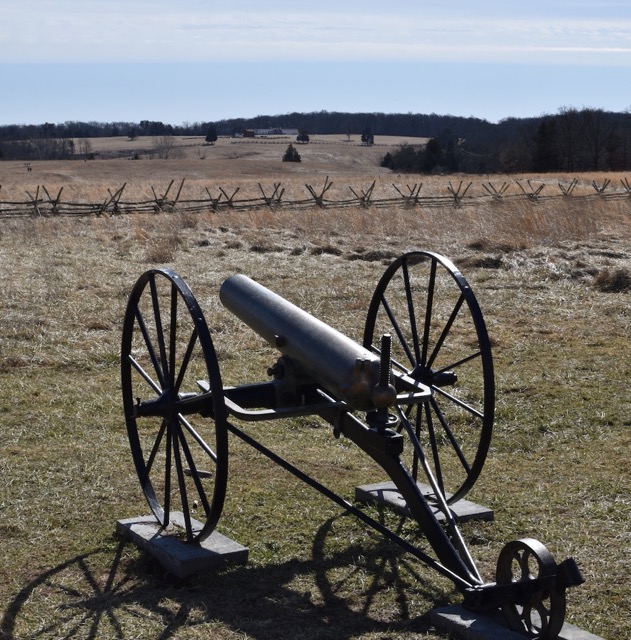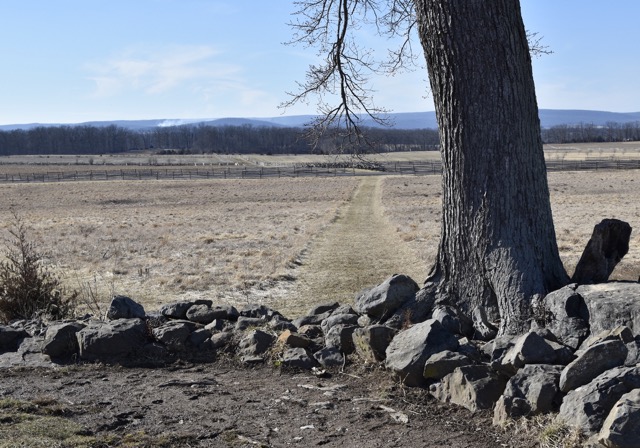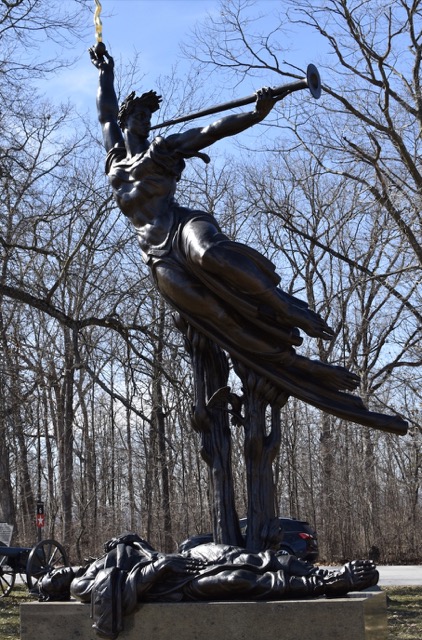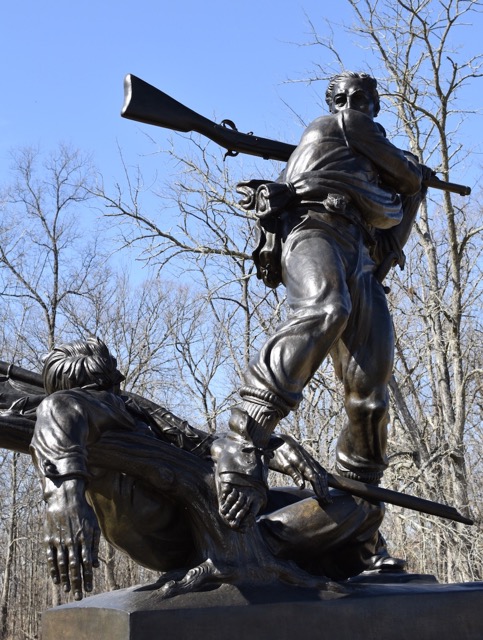Here’s another blog post that starts out with “back when we used to live out here.” I think that one of the upsides about moving to the National Capital Region (Washington Metro, DMV – District of Colombia, Maryland, Virginia) is the ability to go to many of the places that used to be very accessible to us in a previous time in our lives. Mel and I took advantage of our proximity to some of the greatest battlefields of the American Civil War and visited them frequently. Of the many we visited, we seemed to enjoy three of them more often than others: Antietam, Harper’s Ferry, and Gettysburg. Apart from being beautiful places, each of these places saw bloody conflict that played a large role in shaping American sentiment.
Gettysburg National Battlefield quickly became our favorite for a few reasons. First of all, it was extremely accessible. From where we lived, it was a quick 30-minute drive on country roads. There were many times where we had a free afternoon or evening and decided to go visit. Secondly, we absolutely loved riding our bikes through the battlefield. After doing the audio tour many times before and studying the battle, we had a great understanding of the battlefield and how to navigate it. Finally, Gettysburg is a fun little town with little shops, restaurants, and wineries.


One battlefield we hadn’t visited was Manassas (or Bull Run as it was known by the North). Now that we are living about a 30 minute drive from the battlefield, a visit was absolutely in order. There were two major battles that took place in Manassas which were appropriately named the First and Second Battle of Manassas (or First and Second Battle of Bull Run). [Quick note: Mel’s parents came to visit us over the weekend so Tom came along with us to Manassas while Rhonda graciously offered to stay back with Naomi! There will be another post with highlights from their visit – stay tuned!] On this visit, we decided to follow the first of two battles as we maneuvered around the battlefield. The first battle was considered the first major land battle of the Civil War. Both sides believed that the war would be short and could be easily won with quick and decisive offensive campaigns. Folks travelled in carriages and brought picnic baskets to the hills of Manassas to watch the war as if it were some sort of matinee. Everyone quickly learned that war was indeed a terrible endeavor, and that victory would not be cheap or easy. This battle ended in a Confederate victory with a Union Army in retreat and Washington seemingly exposed with 14,000 or so rested Confederate troops within 30 miles of the capital.


If you are unfamiliar with the First Battle of Bull Run, here’s an excellent summary video created by the American Battlefield Trust.
A few takeaways from my time at the battlefield. Based on how the first battle played out, you can easily tell that both sides were unprepared and inexperienced. There were themes of poor artillery placement, ineffective use of infantry, and lack of communication. It is easy to understand why this was the case. Innovations in weaponry and technology had outpaced tactics and strategy. Terrain and supply lines were going to play a major role in the war and neither side employed them effectively during their first meeting in Manassas. Brigadier General Joseph Johnston did make the decision, however, to quickly deploy his troops to battle using rail and many credit this decision with enabling the Confederate victory. Massing troops and supplies would be critical to victory. I also learned that it was at Manassas where Brigadier General Thomas “Stonewall” Jackson earned his famous nickname.


The battlefield itself is well maintained and very well preserved. Nestled among mountains and fields, Manassas is very typical of terrain in this part of the country. I’ve always enjoyed Northern Virginia because of how beautiful it is. (Matthews Hill). Turns out this part of the world is also well suited to grow grapes! I’m sure we will write one (or maybe two) winery posts while we are here. But a quick foreshadow, Virginia contains parts of 9 distinct American Viticultural Areas (AVA, in simple terms “wine growing region”) and we enjoy exploring all of them!






After our battlefield visit, we decided to head next door to The Winery at Bull Run. I don’t want to talk about it too much, because I don’t think it deserves much mention. Its cute and quaint, but they are only out for money. After we got suckered into paying $15 just to sit at a table, we ended up with an $80 bill for one bottle of wine and a “charcuterie board” that was a few sad grapes, some stale crackers and pretzels, and Hormel pepperoni. It was loud, disorganized, and none of the staff seemed to care about taking care of guests. I give it one out of five stars, and the only star they get from me is credited to their proximity to our main destination.
We then headed about 12 miles east to visit another winery, Paradise Spring Winery. This place was also overrun with people enjoying the warm weather, but at least we were greeted upon entry and found a place to sit *FOR FREE* on the enclosed back patio which was enclosed well equipped with heat lamps and a roaring fireplace. There was also live music, which was loud and didn’t really add to the atmosphere or ambiance, but we settled in with a bottle of Cabernet Franc and enjoyed the space. I’d recommend a visit for sure. If you don’t like the crowds, I’d recommend visiting mid-week. I can only imagine that this place will be packed nearly every weekend.
Two days later we took advantage of the 60 degree weather and my day off of work (being a Fed again, I get all the holidays!) and travelled north to visit Gettysburg National Military Park. [Another HUGE thank you to Rhonda for staying back again and watching Naomi!] An hour and a half drive north from DC, Gettysburg is an easy day trip. It felt very familiar to be back there and we settled into familiar places and sights with ease. Gettysburg is one of those places that never gets boring or old no matter how many times you’ve been there before. I learn something new every time I visit. It is a well-known battle that features famous terrain like Little Round Top and Devil’s Den.




The three-day battle ended with “Picket’s Charge” where Major General George Picket lead his formation in a failed assault against Union positions along Cemetery Ridge. This assault is described as the “high water mark of the Confederacy” since it is the northernmost position of the Confederate Army and arguably was their best chance at achieving victory.




The Confederacy suffered a major defeat both physically and mentally at Gettysburg. The war would go on for another two years or so, but the Confederate Army was never able to conduct an offensive at similar size, scale, and effect like what happened at Gettysburg. There is much debate about whether or not General George Meade should have aggressively pursued the retreating Confederate forces from Gettysburg in an attempt to bring an end to the war. It remains one of the most documented and studied land battles of all time.














It was also at Gettysburg that President Abraham Lincoln delivered his famous Gettysburg Address. Less than 5 months after the battle, the President traveled north to Gettysburg to dedicate the Soldier’s National Cemetery. His speech is considered one of the most famous and influential statements of American national purpose and sentiment. The opening phrases are known by everyone, and his address is forever inscribed in the Lincoln Memorial at the West end of the National Mall.
It’s awesome to live in a place with so much living history. We do not take it for granted and are grateful for the opportunities we have to experience it all.


Four score and seven years ago our fathers brought forth on this continent, a new nation, conceived in Liberty, and dedicated to the proposition that all men are created equal.
Now we are engaged in a great civil war, testing whether that nation, or any nation so conceived and so dedicated, can long endure. We are met on a great battle-field of that war. We have come to dedicate a portion of that field, as a final resting place for those who here gave their lives that that nation might live. It is altogether fitting and proper that we should do this.
But, in a larger sense, we can not dedicate — we can not consecrate — we can not hallow — this ground. The brave men, living and dead, who struggled here, have consecrated it, far above our poor power to add or detract. The world will little note, nor long remember what we say here, but it can never forget what they did here. It is for us the living, rather, to be dedicated here to the unfinished work which they who fought here have thus far so nobly advanced. It is rather for us to be here dedicated to the great task remaining before us — that from these honored dead we take increased devotion to that cause for which they gave the last full measure of devotion — that we here highly resolve that these dead shall not have died in vain — that this nation, under God, shall have a new birth of freedom — and that government of the people, by the people, for the people, shall not perish from the earth.
Abraham Lincoln
November 19, 1863

Thanks for the tour!! And adding Lincoln’s address. I played Lincoln in a 7th grade play and memorized the speech. May God guide our footsteps.